Many financial advisors doubt that we can retire comfortably on a million dollars, let alone $500K.
Let me outline our compelling dividend counterpoint—a five-stock portfolio with an average yield of 12.3%.
This generates more than $60,000 in annual income on a $500K portfolio, or a sweet $123,000 in dividends on that million-dollar nest egg. And, most importantly, this “retire on dividends” strategy leaves the principal untouched.
Contrary to popular opinion, we have a pool of dividend candidates. Let’s start with the 879 dividend-paying stocks that yield more than 3% and work our way up the chain:
Believe It Or Not, 50 US Stocks Yield 10%+
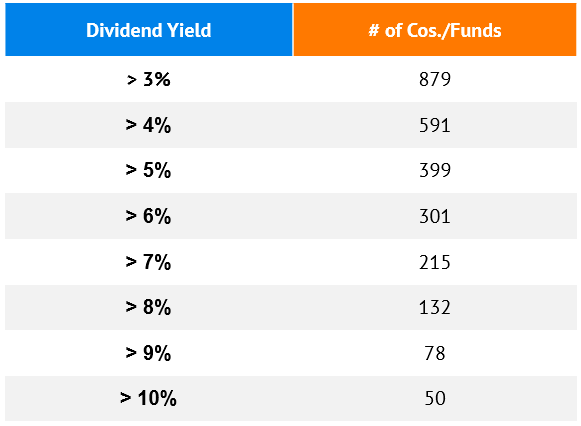
Note: U.S.-listed companies and funds with market capitalizations or AUM greater than $300 million.
Source: Standard & Poor’s
Buying secure dividends like these is the safest way to retire. It’s simple math. Let’s revisit that million-dollar nest egg, which means:
- A 3% portfolio yield will generate $30,000 per year in dividends.
- A 5% yield? $50,000.
- And 12.3%? Again, we’ll earn $123,000 each year just by waking up in the morning.
Yields like that can be a lifesaver to investors working with a smaller egg. At 12.3%, even a $500,000 investment will still generate $61,500 each year!
The key word to making all of this work is “reliable.” We must avoid the dividend traps and focus solely on secure yields. So let’s do a little research together right now and explore five fat yields between 10% and 14.7%.
Capital Southwest (CSWC)
Dividend Yield: 10.0%
Let’s start off by looking at one of the highest-yielding corners of the market: business development companies (BDCs). As a reminder: These firms provide funding to small and midsized businesses that many banks simply won’t lend to; and much like real estate investment trusts (REITs), they’re required to pay out more than 90% of their taxable income in the form of dividends to you and me.
Capital Southwest (CSWC) is a BDC with a two-pronged investment strategy. Its core is “lower middle market” companies with $3 million-$20 million in EBITDA, and then it takes more aggressive shots at “upper middle market” companies in excess of $30 million in EBITDA, with a willingness to use a bit more debt leverage than in its core deals.
CSWC’s current portfolio is 86 companies; it added eight new holdings in the most recent quarter, including visual effects firm Crafty Apes and dive computer manufacturer Shearwater Research.
Also recently, CSWC issued new debt to replace higher-cost debt, and made changes to its revolving credit facility, which will help boost the company’s core net interest income (NII) going forward.
Naturally, though, the dividend is the reason to take notice of CSWC.
For one, the company recently announced a 6.8% jump in its regular dividend to 47 cents per share. That brings its core yield to an even 7%. The rest of that yield comes from supplemental dividends—three 10-cent payouts in the past three quarters, and a 50-cent dividend for the quarter ended Dec. 31. That rounds out the payment to 10% on the dot.
Special dividends can be a useful tool for sage management teams. Rather than promise a massive regular dividend that the company might risk missing some years, a “regular” special, or supplemental, dividend from profits each quarter allows companies to dole out additional rewards when times are good, but pull back during tighter financial times without spooking shareholders.
Those Payouts Add Up
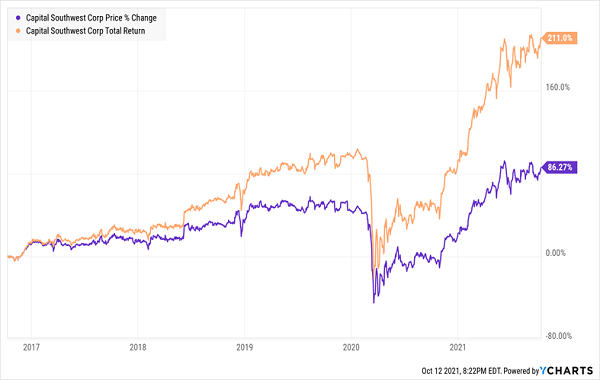
Shell Midstream Partners LP (SHLX)
Dividend Yield: 10.4%
Most everyone knows that master limited partnerships (MLPs) are typically good for sky-high yields, and that’s certainly the case with Shell Midstream Partners LP (SHLX), which at current prices is offering up a double-digit payout.
Shell Midstream Partners LP is a collection of onshore and offshore pipelines, terminals and storage, and gathering and processing assets for crude oil, gasoline, fuel oil and other energy products. Its infrastructure stretches from coast to coast, though its offshore pipelines are clustered in the Gulf of Mexico.
SHLX’s super-sized distribution is particularly noteworthy given that it reflects a drastically reduced payout. While most energy companies that were going to drop their dividends did so in 2020, Shell Midstream held on to its 46-cent payout up until late July, when it announced a 35% haircut, effective as of the Q3 distribution.
And It’s Safe to Say Most Investors Saw It Coming

If there’s any upside to a distribution cut—especially when the yield is still north of 10%—it’s that you can reasonably expect the remaining distribution to be safer (its estimated distribution coverage for the year is now a secure 1.3x), and the company to have more financial flexibility.
The problem is, it’s a few months down the road, and SHLX hasn’t provided a clear outlook for what it will do with this newfound flexibility. Will it invest in growth? Will it buy back units? No one knows.
And don’t forget that investing in an individual MLP means you get the added headache of the annual K-1.
Icahn Enterprises LP (IEP)
Dividend Yield: 14.7%
Icahn Enterprises LP (IEP) is both an example of how much of a difference big dividends can make—and how that difference still might not be enough to warrant a purchase.
Icahn Enterprises LP is, as you might have guessed, named for that Icahn—Carl Icahn, noted activist investor known, among other things, for his successful Herbalife (HLF) bet against Bill Ackman. This holding company operates across eight main business segments: investment, energy, automotive, food packaging, metals, real estate, pharma and home fashion.
Its subsidiary companies and stakes include (among other things) petroleum refiner CVR Energy (CVI), auto parts suppliers AAMCO and Pep Boys, and pharmaceutical firm Vivus, not to mention the investment business, Icahn Capital LP.
This isn’t what one would call a “consistent” business. Consider that IEP lost $8.07 per share in 2016, swung to a profit of $14.94 per share in 2017, followed that up with another $11.33 per share in 2018, then lost $5.38 and $7.33 per share in 2019 and 2020, respectively.
Icahn still manages to pay a monster dividend—a payout so big that it makes a noticeable kick to returns in a single quarter.
More Than 3 Percentage Points of Return in Just 3 Months
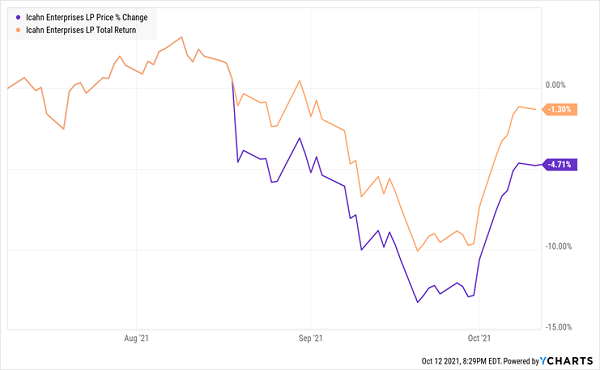
Even then, however, he just can’t keep up with Mr. Market.
It’s Not a Smooth Ride, Either
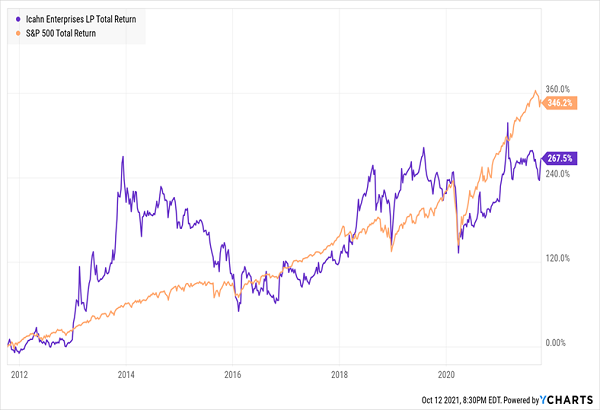
As 2013 and 2019 illustrate, IEP is good for the occasional swing trade. But if you want to hold on long-term, consider springing for some Tums.
Global X Nasdaq 100 Covered Call ETF (QYLD)
Dividend Yield: 11.8%
From time to time, you can squeeze double-digit yields out of the fund world, too. For instance, the Global X Nasdaq 100 Covered Call ETF (QYLD) delivers nearly 12% in payouts by leveraging a common options technique.
It sells covered calls.
QYLD holds the components of the Nasdaq-100, then it sells call options on the index to generate cash flow. The upside of this strategy is the ability to generate income from options trading. The downside, however, is that you effectively cap the upside from your long positions.
That’s a problem when you’re capping the upside of a growth machine.
So Much Price Performance Left on the Table
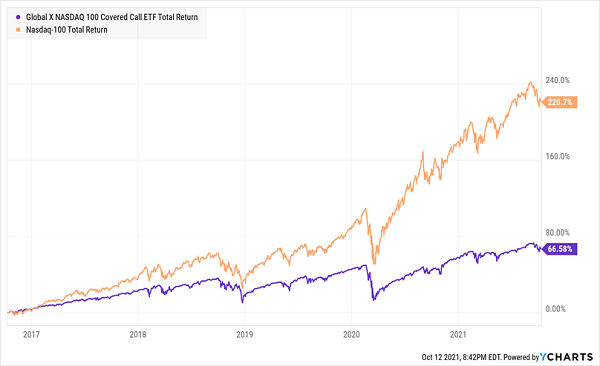
One of my biggest complaints about the strategy is that options on the index itself pale in comparison to options on the individual stocks therein. It’s a great idea—but one that the human managers of a closed-end fund (CEF) could probably squeeze more potential from.
Cornerstone Total Return Fund (CRF)
Dividend Yield: 14.5%
In general, CEFs are a great place to look for yield. Unlike their mutual fund and ETF cousins, closed-end funds have a few natural advantages—among them that they can use debt leverage to amplify their exposure, and as a result, juice their price performance and their yields.
Consider the Cornerstone Total Return Fund (CRF), which yields north of 14% by investing not in any kinky asset classes or dipping into options, but instead via a portfolio of about 140 mostly U.S. large-cap stocks.
That’s it.
CRF does utilize a modest amount of debt leverage (~10%) to get more out of management’s selections, but otherwise, it’d be difficult to pick this fund out of a lineup. Apple (AAPL). Microsoft (MSFT). Berkshire Hathaway (BRK.B). Really straightforward.
So, how does a basic large-cap fund with a 14%-plus yield do this?
Cornerstone Gets Crushed
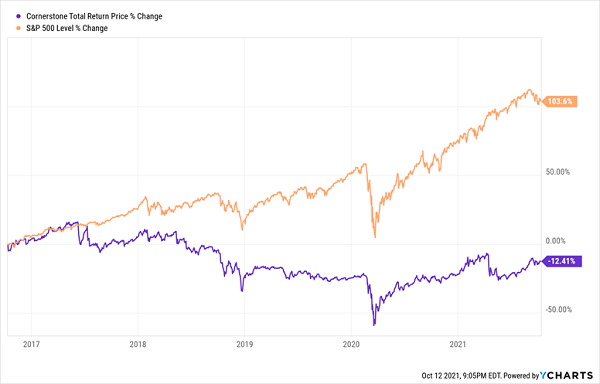
That’s because most of the yield from CRF isn’t traditional dividend income. Technically speaking, we’re getting a generous monthly “payout” from CRF, but about 94% of that is actually “return of capital,” which has different tax consequences.
That can be a red flag in some circumstances, and so is this: While CEFs can and do trade at discounts to their net asset values (NAV), Cornerstone has traded, on average, at a roughly 15% premium to its underlying holdings over the past five years—and currently is priced at a whopping 32% premium.
Sky-High Dividends You Can Count on for DECADES
Did you notice something with all of those high yielders?
They’ve got a lot of “buts.”
- Nice yield … but most of it isn’t even real income.
- Great payout … but the price returns are shoddy.
- What a dividend … but the stock swings around like Tarzan.
The majority of the market’s most mouth-watering payouts force you to make some sort of critical tradeoff. But a few select gems offer it all: The right payout, the right price, the right potential.
And these stocks are all part of my “Perfect Income” portfolio.
Many of my readers have told me that these stocks have doubled and even tripled the dividends they were earning from their old income portfolios.
That alone is a massive upgrade to any set of retirement holdings. But more important is that my Perfect Income Portfolio delivers that level of cash while also …
- Paying those dividends consistently, predictably and reliably.
- Surviving, even thriving, in market crashes.
- Delivering double-digit returns across several safe investments.
- Gambling your hard-earned nest egg on flimsy day-trading strategies, options contracts or penny stocks.
Let me show you the stocks and funds you need to stabilize your retirement. But more importantly, let me teach you more about this incredible strategy itself and make you a better investor in the process!
Take control of your financial legacy today. Let me show you how to get 2x to 4x your current income with this simple, straightforward system. Click here to get a FREE copy of my Perfect Income Portfolio report, including tickers, dividend yields, full analyses of each pick … and a few other bonuses!

Recent Comments